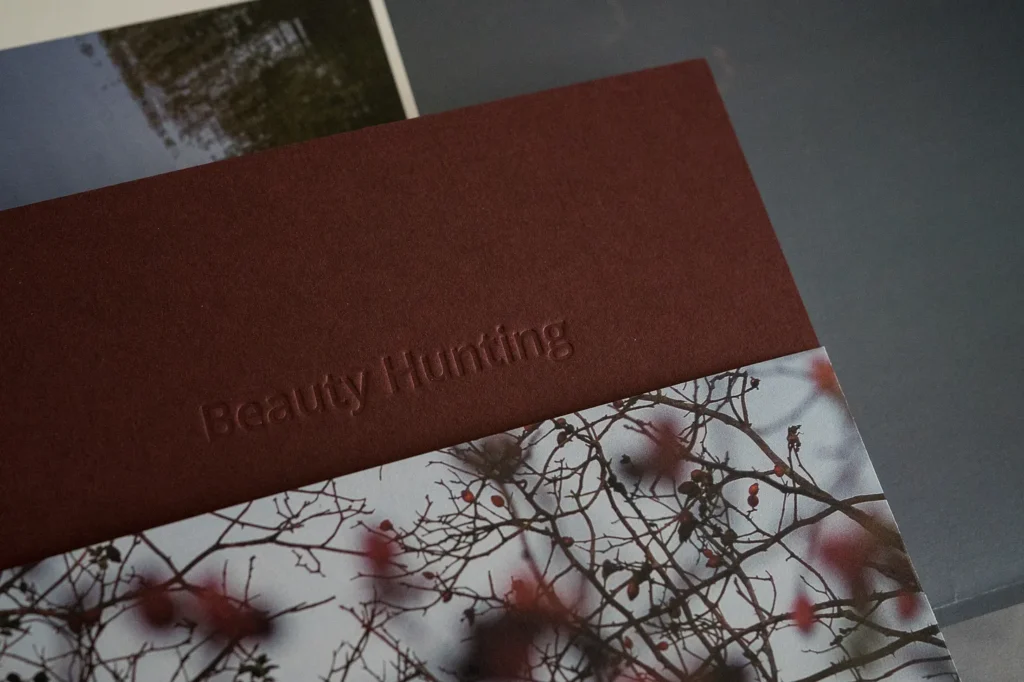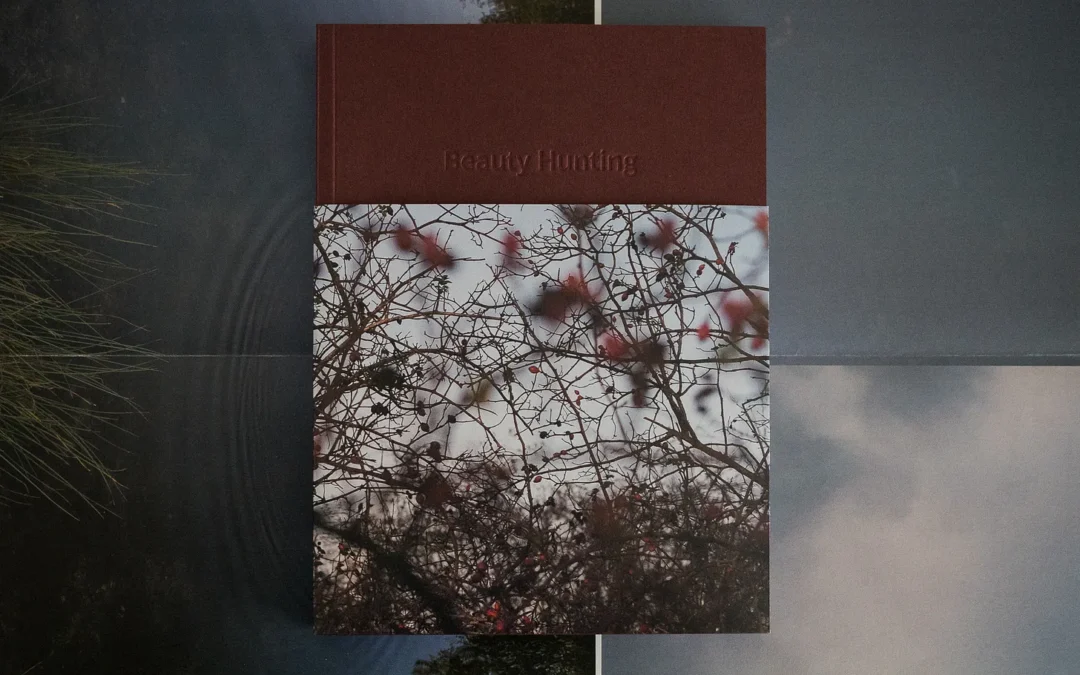Beauty Hunting is now a book – it has been for about six months now. Like, an actual book that you can hold in your hands and buy a copy of. A book with my name on it that exists in the world.
It’s quite something.
It’s always so nerve-wracking to put something like this into the world, especially something so deeply personal. You never quite know whether people will get what you’re trying to say – or not.
Based on the feedback and the little notes I’ve been receiving so far, people do get it. It makes me very happy.
But this post isn’t about it. I thought I’d get nitty-gritty and write down all the numbers and tell you how much publishing a very modest print run of a quality photography book actually costs. So here we go.
Book design
I’m not a stranger to putting photographs in sequences and layouts – I’ve worked as a people photographer for 15 years now, and have designed plenty of family and wedding albums. But this was something completely different and I have quickly realised that I may not able to do this one on my own after all.
So for this book I decided to work with a book designer. There was a lot of material to make sense of, and this being my first book project I felt I needed some a lot of handholding, and someone who understands the process better than I do. I don’t regret doing this and I learned so much in the process.
The total cost of working with a book designer that took well over a year (mostly because I was very slow) was 1600 euro, which is approximately £1300.
I ended up with a correctly sized InDesign file that I could send straight to the printer but that I since adjusted, moving things around a bit, and removing some of the photographs before I finally pressed print on the book late last year.
During that process there were additional costs to print out the photographs so I could stick them to my bedroom wall and move them around, seeing which images I wanted to keep and which ones needed to go – really the only way to make sense of a large body of work is by actually printing the photographs out and staring at them for a few weeks. I suspect that must have been around £50 all in all, as those were fairly cheap prints.
Initial book dummy
The original plan working with my book designer was that she would print a book dummy with her local printer that she knows well, and will take care of correct colour reproduction. That dummy would then be the one I could use to find a printer in the UK, as many do offer a service of matching an already existing dummy. We even considered an idea of printing a small run that I would then take home in a suitcase during my next visit! This was important to me as for my client work I was used to working with an album supplier that works with sRGB files and is designed for… well… colour calibration dummies and takes care of everything with secret colour management profiles that make everything look amazing, but I now needed to learn to work in CMYK and potentially offset processes and that was proving tricky and I really wanted to get someone else to manage it all for me.
Geopolitical events of 2022 put a wrench in that plan just as we were nearing the final stretch of the project (my designer was based in Russia) and I was left to figure out a lot of things on my own… which was hard, frustrating and why it took me so long to finally get there – again, learning A TON in the process.
After much looking I initially went with ExWhyZed as it came recommended by many. They were decent enough but ultimately I didn’t love the paper they could offer me, and to be honest I didn’t feel very well looked after. A bound book dummy cost me £208 (yes just for one copy plus some test sheets) and I didn’t even like the colour reproduction which was partly a problem on my end but partly not amazing communication and hand-holding on their end.
If you know exactly what you’re doing and you don’t have fancy requirements then I’d imagine they are still a solid choice, so I’m not dunking on them, but that bound dummy didn’t need to happen and I should have been talked out of it by someone who was supposed to know better. I wasn’t and that left a sour taste in my mouth (perhaps unfairly, but it is what it is).
I wrote this off as a cost of learning through doing and fucking up in the process.

Final book printing
After a lot more searching I ended up with Gomer Press, a family-run printing company based in Wales. Their name came up in discussions on photobook sustainability and it was good to know our values aligned. I also knew I wanted to print in the UK to (a) support a local business and (b) reduce carbon output of shipping books from overseas, be it China or Turkey or Italy, where I know a lot of photography books get printed.
I felt well looked after from the start and they were insanely patient with me as it took me about a year from initial enquiry and many many different quotes to finally hitting print (huge shout out to my account manager Damien!). Even though there were a few frustrating hick-ups along the way I feel like they went above and beyond and overall I had great experience with them and would definitely use them again – if they’ll have me, haha!
The total cost of the print run of 100 books was £1640. Then there was some studio colour grading and retouching work and digital and physical proofing which totalled an additional £300.
I also decided to purchase an ISBN number for the book (you don’t have to, but it makes things more official). That cost me £174 for a block of 10 (which works out WAY cheaper per number than just buying a single one, and I know I’d probably want to make more books in the future so it was worth it for me, but that is a few years into the future so I’m including the full cost in this calculation).
Postage
Between cardboard packaging, thank you cards and postage fees, I spent approximately £225 on posting the books out to my Kickstarter supporters.
Final math
So here the total (where’s an integrated spreadsheet when you need one?)
+---------------------------------------+-------+
| Book designer: | £1300 |
+---------------------------------------+-------+
| Prints for sequencing: | £50 |
+---------------------------------------+-------+
| First book dummy: | £208 |
+---------------------------------------+-------+
| More print tests: | £300 |
+---------------------------------------+-------+
| ISBN numbers: | £174 |
+---------------------------------------+-------+
| Actual final print run of 100 books: | £1640 |
+---------------------------------------+-------+
| P&P: | £225 |
+---------------------------------------+-------+
| TOTAL: | £3897 |
+---------------------------------------+-------+That’s approximately £39 per book. And that doesn’t even include my “salary” for all of the time I spent working on it.
I ran a Kickstarter campaign for people to pre-order the book and pay for some of the printing costs – but as you’ll see it wasn’t anywhere near what it actually cost me to put it all together.
My Kickstarter campaign raised a total of £2,446 (which was above my modest goal of £1850, yay for that). Between dropped pledges (when someone’s card gets declined at the end of the campaign) and Kickstarter fees my total payout from that campaign was £2,146.30 – enough to cover the final print run and postage but not much else.
Why did I set a goal so low, knowing full well that it would nowhere near cover my expenses or time? Well it’s because the first Kickstarter a run six months prior didn’t succeed and I only raised £1,936 of the £5,900 goal which was way closer to what I actually needed and maybe even earn some money on top to cover my time (this goal was for a larger print run of 250 books so my costs would have also been higher).
Most photographers who publish or self-publish photobooks don’t do it for money (and from what I hear, most writers don’t get rich off their fiction or non-fiction books either with only mostly celebrity exceptions). We do it because we have a passion for the art form, and have something to say that we want to share with the world. The best way you can support your favourite photographer / artist is to buy their books and/or prints.
Yes, that’s my not-so-subtle hint to buy my book. As of now, I have about 40 copies of the initial edition left and I’d love nothing more than for all of them to find a good home.
You can read about the lessons I’d learned from running and failing a Kickstarter here, by the way, and that includes the breakdown of my decision to go with a very low amount.
Useful resources
Here are some resources to get started in making your own photobook. I am likely forgetting something and I’ll probably come back to this list to update it:
Sustainable Photobook Publishing Network has a lot of information on issues around environmentally conscious approaches to photobook publishing, including case studies.
The papers I chose for this book came from GF Smith for the cover and Fedrigoni for the pages. These are some of the more expensive papers but they are among the best for sustainability also have the incredible tactile feel to them that was important to me.
Self Publish Be Happy has video lectures, resources and inspiration on publishing books and zines.
Martin Parr Foundation Library has plenty of photobooks, both self-published and not, many out of print, to research how it’s done and get inspired. I have visited it twice and it was invaluable. V&A London now also has a photography wing that has plenty of reference photobooks, some you can request in advance (although I have personally found the catalogue search function impossible to navigate unless you know exactly what book you’re after… which I don’t, I just mostly go on vibes). The Photobook Cafe in London also has a selection of books on display, and so of course does The Photographer’s Gallery bookshop. One of my favourite photobook publishers to get inspired by is Overlapse.

